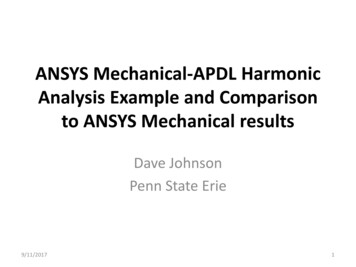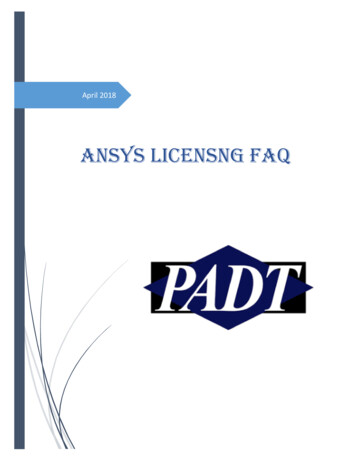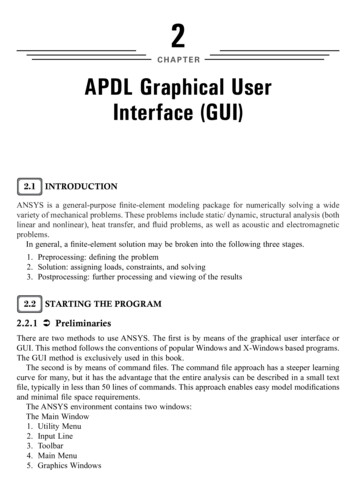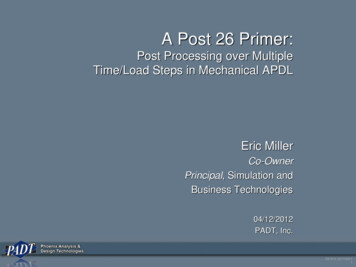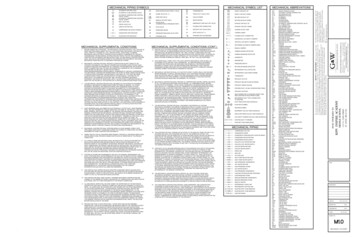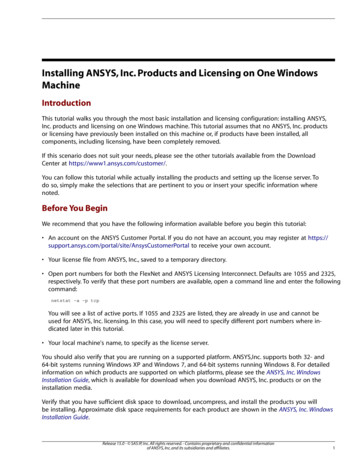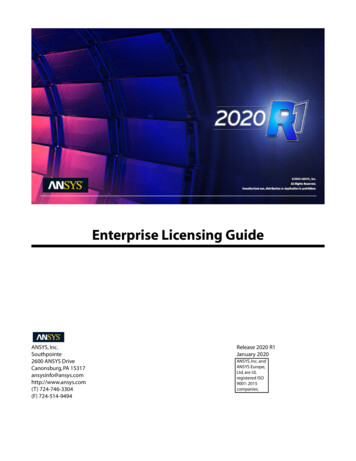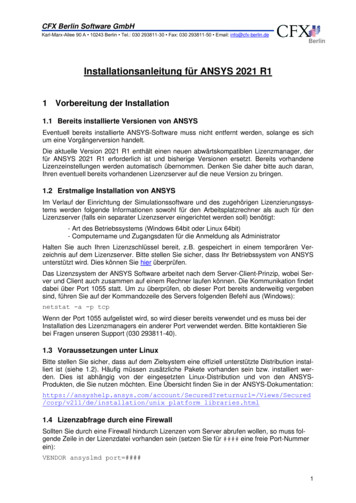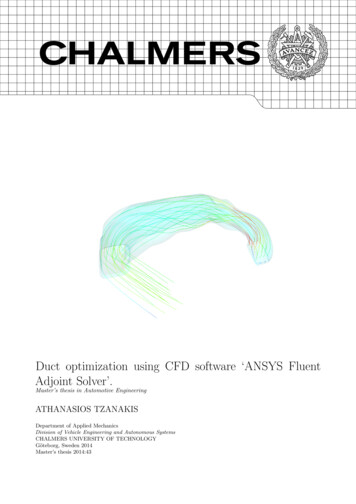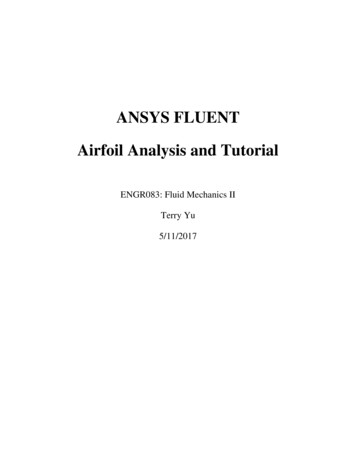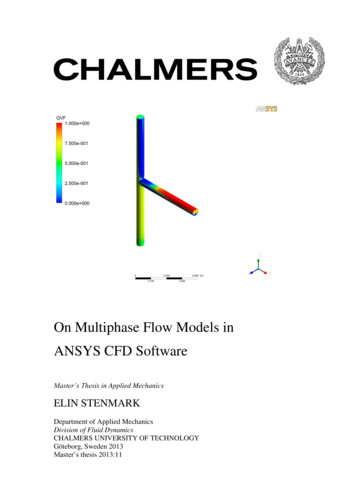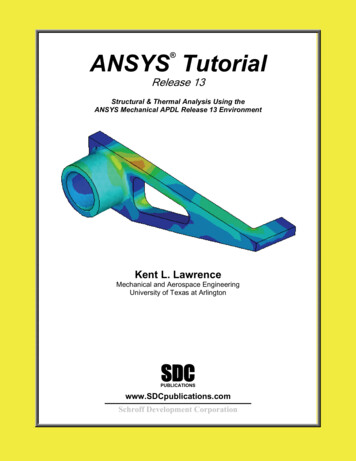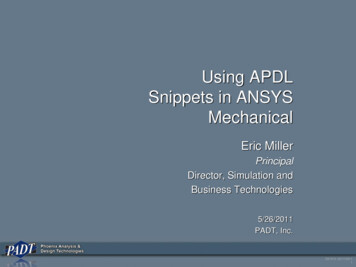
Transcription
Using APDLSnippets in ANSYSMechanicalEric MillerPrincipalDirector, Simulation andBusiness Technologies5/26/2011PADT, Inc.DX R13: 02/17/20111
Agenda Note: This presentation is beingrecorded IntroductionsBackground and FoundationItem SnippetsGeneral Prep SnippetsGeneral Post SnippetsOther Stuff to KnowConclusionDX R13: 02/17/20112
IntroductionsDX R13: 02/17/20113
Upcoming Webinars Webinars go on Summer Breaks in June and July Look for an e-mail in early June with next webinars– Will introduce “User Issues” where you suggest a topic and weresearch and do the presentation See upcoming and past webinars at:– padtincevents.webex.com Click on ANSYS Webinar SeriesDX R13: 02/17/20114
About PADT PADT is an Engineering ServicesCompany– Mechanical Engineering– 17 Years of Growth and Happy customers– 68 Employees 3 Business Areas– CAE Sales & Services Consulting, Training, Sales, Support– Product Development– Rapid Prototyping & Manufacturing Learn More: www.PADTINC.com“We Bring Dimension to Your Ideas”DX R13: 02/17/20115
Cube HVPC Systems Balance between speed and cost– Mini-Cluster96 Cores / 256 GB RAM / 3.6 TB DiskMobile Rack / UPS / Monitor / Keyboard 43,250– Compute Server32 Cores / 128 GB RAM / 3 TB Disk 12,300– Simulation Workstation12 Cores / 64 GB RAM / 1.5 TB Disk 5,800– Simulation Fileserver10 TB Disk / External eSATA 5,800 www.CUBE-HVPC.comDX R13: 02/17/20116
PeDAL – The APDL Editor Side-by-side editor and help viewer layout.Instant help on any documented APDL command by pressing F1.Full syntax highlighting for ANSYS v12 Mechanical APDL.Auto-complete drop downs for APDL Commands.APDL Command argument hints while typing commands.Search ANSYS help phrases and keywords.Multiple tabs for the editor and html viewer.Full capability web browser built in allows for rich web experience and websearches.DX R13: 02/17/20117
Connect with PADTFacebook:facebook.com/padtincEmail inkedIn:Search on PADT, Inc.ANSYS User Blog:padtinc.com/focuswww.padtinc.com/epubsDX R13: 02/17/20118
Background andFoundationDX R13: 02/17/20119
APDL? ANSYS Parametric Design Language– The ANSYS program, now Mechanical APDL (MAPDL), originallyworked by reading command files: COMMAND, arg1, arg2, arg3, arg4 Punch cards!– Using the GUI simply builds a command(s) that are sent to theprogram– A logical improvement was to turn the command stream into alanguage Variable substitution for any argumentsSimple math with variablesAdded control logic: if-then-else, do, gotoAdded ability to interrogate the database and return valuesAdded ability to deal with data as arrays, vectors, and matrices Everything you can do in MAPDL you can do through aseries of text commands: APDLDX R13: 02/17/201110
Why is APDL Worshiped? No Limits– Everything you can do in MAPDL you can do through a series of textcommands: APDL– Everything in APDL can be parameterized– Almost everything about your model can be interrogated Easy to learn and use– Very consistent– Well documented– Can start with contents of log file! Simple– Concise, man-readable– Old limits on character length (8char) keep things short Every item in a MAPDL is identified by a number– Very Important!DX R13: 02/17/201111
Mechanical and APDL When you use ANSYS Mechanical you are building anobject oriented description of your model When you hit solve, it converts the description into APDL– Runs MAPDL in batch To add a new function to a complex object oriented systemis tough– But many features users want exist in MAPDL– Especially advanced functions and additional options So, users can add APDL commands to their model– As an object in the pre- or post-processing branches Allows user access to the full breadth and depthDX R13: 02/17/201112
Command Objects Users insert “Command Objects” into the tree to insert APDLcode Originally called “code snippets” many users still call themsnippets But documentation refers to them as Command Objects Icon is a text file with a big Red C– (APDL) indicates the type of snippet, you can do other solvers – Decoration (Green check, yellow Lighting bolt, question mark) is thesame as for other objects in your model tree.DX R13: 02/17/201113
Not Perfect You may not be able to post process your model– Some things done to results can not be viewed in Mechanical You can’t touch geometry– Only works on FE model, not on geometry– KP, Line, Area, Volume don’t exist in MAPDL from Mechanical Not interactive in Workbench– You can’t try out commands and see what happens from insideMechanical– You can only imbed APDL code in batch solves, even when workinginteractively– Plotting and listing is to files onlyDX R13: 02/17/201114
You Need to Know Some MAPDL Biggest issue we see with Command Objects in Techsupport:– User typed in their script and then ran their model – didn’t work You need to be able to fire up MAPDL interactive– Read in ds.dat file or save *.db and *.rst and resume/set– Then try out your scripts and check that they work You are using the extensive features available in MAPDL– You can’t treat it as a black box. If you are not familiar with MAPDL– The documentation is very good– Work interactive, commands go in log fileDX R13: 02/17/201115
The MAPDL Input File When you click Solve Mechanicalmakes a ds.dat file– Use the Files tool in Project to find thefile Or you can save one anywhere youwant– Or click anywhere on your solution branchand then use Tools- Write Input file DX R13: 02/17/201116
Example – No SnippetsDX R13: 02/17/201117
Adding Snippets Click on Valid Object in Tree then– Click on Commands Icon– RMB- Insert- Commands Insert as many as you want– Executed in orderDX R13: 02/17/201118
Command Text Window When you click on a Command Object you get a text windowtab called “Commands” Enter and view your APDL code in hereDX R13: 02/17/201119
Linking to a Macro file You can associate a CommandObject with a text file– Usually *.mac, but also *.txt Export creates a file from your text Import links to an existing file Refresh replaces the text windowwith what is in the file File name and status are shown inDetails viewDX R13: 02/17/201120
Three Types of Snippets Item Snippets– Are attached to an item in the tree– Contains APDL that modifies only thatitem– Some ID is set for the item number Prep– General commands that get executedright before the solve command Post– Post processing commands that getexecuted right after the solveDX R13: 02/17/201121
Be in the Right Module ANSYS runs usually go through three modules:– /PREP7, /SOLU, /POST1 APDL commands for a given module only work in thatmodule Items: /PREP7 PREP: /SOLU POST: /POST You can move in and out of modules, but make sure you goback to where you started– Very important for PREP snippets!DX R13: 02/17/201122
Objects you can Add Command Objects ToTypeTree ObjectBodyInserted in APDL FileAfter material for that body is definedMATIDContact PairAfter contact is definedTID, CID for Type,Real and MatJointAfter the joint definitionJIDAfter spring definitionSID.ITEMSpringPREPPOSTIDEnvironmentRight Before the Solve CommandSolutionRight after the /POST1 commandPre-StressBefore first solve in Pre-stress modalDX R13: 02/17/201123
Command Object RMB File Operations Standard object tools––––SuppressDup, Copy, CutDelete, renameRename Based onDefinition Shows File name if youare linked to a file.DX R13: 02/17/201124
Command Object Details View The same for Item and PREPCommand Objects File name and status if you arelinked to a file Suppression flag Target– This is where you can point to othersolvers besides MAPDL Input arguments for your script– They can be parameters managedby Workbench!DX R13: 02/17/201125
Command Object Details View: POST POST Adds ability to bring backparameters User defines prefix for it to use– my is default Result can be a parameter More on this in Post sectionDX R13: 02/17/201126
Other and General Things to Remember Anything valid in APDL is valid in a snippet– Except geometry and interactive graphics stuff Command snippets do get copied to Reports Use Duplicate and drag and drop If no changes to script on Item snippets, link to the same file!– Example: 32 contact pairs that all have the same advanced options Remember that Mechanical generates APDL code Be aware of location that Mechanical inserts snippets Try and use Item Snippets when possible– ID makes it easy Use files for complex snippets Rename your snippets with useful namesDX R13: 02/17/201127
Item SnippetsDX R13: 02/17/201128
Adding Command Objects to Objects An object in the tree gets convert to a block of APDL code The Command Object let’s you append your own code Nice because number of the object is passed to you as aparameter Body– Really material. This is the most used Contact Pair, Joint, Springs– Use this to get access to advanced features Strongly recommend using files for these– Especially if the same scripts are applied to multiple objects– Use Arg1-9 to specify anything unique for a given object Don’t change item numbers in APDLDX R13: 02/17/201129
Example: APDL Material for a Body Usually used for advanced materials not supported inMechanical!!Commands inserted into this file will be executed just after material definitions in /PREP7.The material number for this body is equal to the parameter "matid".!Active UNIT system in Workbench when this object was created: U.S. Customary (in, lbm, lbf, s, V, A)! 0007,.00069,.00066,.00065mpdata,ex,matid,1,29e6 ,28.9e6,28.5e6,27e6! ERMSNIP MP,NUXY,1,0.3,MP,MURX,1,10000,/wb,mat,end! done sending materials! ****** Begin Command Snippet *******set,matid,1!Commands inserted into this file will be executed just after material definitions in /PREP7.!The material number for this body is equal to the parameter "matid".!Active UNIT system in Workbench when this object was created: U.S. Customary (in, lbm, lbf, s, V, A)! 0007,.00069,.00066,.00065mpdata,ex,matid,1,29e6 ,28.9e6,28.5e6,27e6! ERMSNIP! ****** EndCommand Snippet ******!************************* Model Summary ******************** DX R13: 02/17/201130
Comments on Item Command Objects You can also use the body object to change the elementtype, section, or real by body– MATID also refers to TYPE and REAL– Great place to change away from default 185 for solid elements Before you go down the road of a fancy Item snippet, makesure that a new feature in Workbench can’t do it– Lots of things we used to write snippets for are available nowDX R13: 02/17/201131
GeneralPreprocessingSnippetsDX R13: 02/17/201132
General Modifications of Your Model Executed right before the SOLVE command So you are in the /SOLU module– Ok for Loads, constraints, and solution options– Not OK for materials, moving/creating mesh, etc You can go back to /PREP7 if you need to– Just remember to return to /SOLU The sky is the limit on what you can do here– But remember, if you create items (nodes, elements, numbering,etc.) you can’t post process in WorkbenchDX R13: 02/17/201133
Selecting Items to Work On Everything in MAPDL has a number associated with it Item Snippets group by some ID– Material ID, Contact Pair, Joint ID, etc But for general stuff you have three choices:– APDL selection logic– Named Selections - Nodal Components– Combine named selection and APDL selection logic Named Selections– For Every geometry object you name with Named Selection– And, every geometry object you assign a nodal load or constraint– A nodal component gets created in MAPDL Note that load names may be tricky to figure out Recommend using named componentsDX R13: 02/17/201134
Named Selection Remember that it makes a nodal component for the nodes that sit on thegeometry your select– Body named selections don’t get turned into APDL They show up in your DS.DAT file as shown Use descriptive names Some users actually encode stuff they want to pass in the NamesSelection– F Hydro 34– Write a macro that loops through components Looks for ones starting with F Hydro Applies a hydrostatic load assuming the highest node is at 34 feet– Can get very fancy/com,*********** Send tion as Node Component ***********121523162417181920DX R13: 02/17/201135
Parameters User ARG1-ARG9 in Details to pass in Parameters– If you need more, use multiple Command Objects You can also define parameters that you want passed backto Mechanical– A trick required – Only user parameters with prefix in a PostCommand Object are brought back– So, add a my param my param to a post object as a workaroundPREP Command Object!Commands inserted into this file will be executed just prior to the Ansys SOLVE command.!These commands may supersede command settings set by Workbench.!Active UNIT system in Workbench when this object was created:nsel,allnlist,all*get,my nmx,node,,num,maxU.S. Customary (in, lbm, lbf, s, V, A)POST Command Object!Commands inserted into this file will be executed immediately after the Ansys /POST1 command.!Active UNIT system in Workbench when this object was created:nsel,allset,last*get,my stmx,active,,set,sbstmy nmx my nmxU.S. Customary (in, lbm, lbf, s, V, A)DX R13: 02/17/201136
GeneralPostprocessingSnippetsDX R13: 02/17/201137
Getting Access to Full MAPDL POST Puts you in /POST1–––––Make plots not supported in MechanicalQueries and calculationsReturn scalar values as parametersGraphsMake output files that you need for other programs A
Mechanical and APDL When you use ANSYS Mechanical you are building an object oriented description of your model When you hit solve, it converts the description into APDL – Runs MAPDL in batch To add a new function to a complex object oriented system is tough – But many features users want exist in MAPDL – Especially advanced functions and additional options So, users can .
